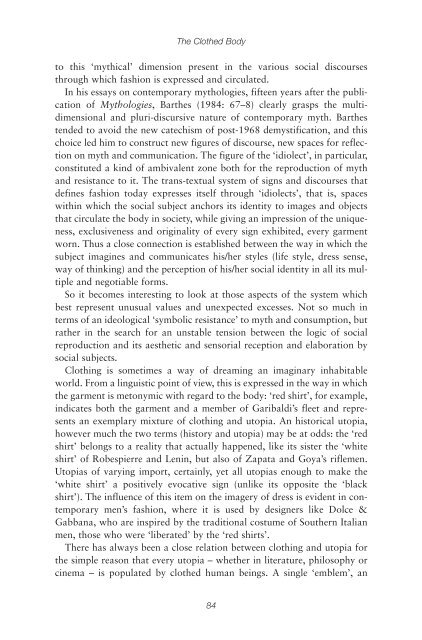Create successful ePaper yourself
Turn your PDF publications into a flip-book with our unique Google optimized e-Paper software.
<strong>The</strong> <strong>Clothed</strong> <strong>Body</strong><br />
to this ‘mythical’ dimension present in the various social discourses<br />
through which fashion is expressed and circulated.<br />
In his essays on contemporary mythologies, fifteen years after the publication<br />
of Mythologies, Barthes (1984: 67–8) clearly grasps the multidimensional<br />
and pluri-discursive nature of contemporary myth. Barthes<br />
tended to avoid the new catechism of post-1968 demystification, and this<br />
choice led him to construct new figures of discourse, new spaces for reflection<br />
on myth and communication. <strong>The</strong> figure of the ‘idiolect’, in particular,<br />
constituted a kind of ambivalent zone both for the reproduction of myth<br />
and resistance to it. <strong>The</strong> trans-textual system of signs and discourses that<br />
defines fashion today expresses itself through ‘idiolects’, that is, spaces<br />
within which the social subject anchors its identity to images and objects<br />
that circulate the body in society, while giving an impression of the uniqueness,<br />
exclusiveness and originality of every sign exhibited, every garment<br />
worn. Thus a close connection is established between the way in which the<br />
subject imagines and communicates his/her styles (life style, dress sense,<br />
way of thinking) and the perception of his/her social identity in all its multiple<br />
and negotiable forms.<br />
So it becomes interesting to look at those aspects of the system which<br />
best represent unusual values and unexpected excesses. Not so much in<br />
terms of an ideological ‘symbolic resistance’ to myth and consumption, but<br />
rather in the search for an unstable tension between the logic of social<br />
reproduction and its aesthetic and sensorial reception and elaboration by<br />
social subjects.<br />
Clothing is sometimes a way of dreaming an imaginary inhabitable<br />
world. From a linguistic point of view, this is expressed in the way in which<br />
the garment is metonymic with regard to the body: ‘red shirt’, for example,<br />
indicates both the garment and a member of Garibaldi’s fleet and represents<br />
an exemplary mixture of clothing and utopia. An historical utopia,<br />
however much the two terms (history and utopia) may be at odds: the ‘red<br />
shirt’ belongs to a reality that actually happened, like its sister the ‘white<br />
shirt’ of Robespierre and Lenin, but also of Zapata and Goya’s riflemen.<br />
Utopias of varying import, certainly, yet all utopias enough to make the<br />
‘white shirt’ a positively evocative sign (unlike its opposite the ‘black<br />
shirt’). <strong>The</strong> influence of this item on the imagery of dress is evident in contemporary<br />
men’s fashion, where it is used by designers like Dolce &<br />
Gabbana, who are inspired by the traditional costume of Southern Italian<br />
men, those who were ‘liberated’ by the ‘red shirts’.<br />
<strong>The</strong>re has always been a close relation between clothing and utopia for<br />
the simple reason that every utopia – whether in literature, philosophy or<br />
cinema – is populated by clothed human beings. A single ‘emblem’, an<br />
84

















